Photo by Danny Swainson
Aaron Androsoff, Fisheries Technician with BCCF, reaches to clip a piece of tackle to a downrigger line while microtrolling for juvenile Chinook and Coho salmon in Maple Bay in the Salish Sea for the Bottlenecks project.

Aaron Androsoff, Fisheries Technician with BCCF, reaches to clip a piece of tackle to a downrigger line while microtrolling for juvenile Chinook and Coho salmon in Maple Bay in the Salish Sea for the Bottlenecks project.
At the Pacific Salmon Foundation (PSF), our purpose is to save and restore wild Pacific salmon.
The decline in Pacific salmon is one of the most urgent environmental concerns for British Columbians. More than 85 per cent of B.C. residents indicated a high level of concern for dwindling salmon populations. Public concern, combined with unprecedented climate-change events — heat dome, wildfires, drought, floods — and the integral nature of salmon to ecosystems, results in a clear challenge that is urgent and important to the people of B.C.
“A large cross section of British Columbians care deeply about the state of Pacific salmon and appreciate the complex risk factors contributing to serious declines of many populations. Pacific salmon need our help urgently, and we must do everything we can to save them.” — Michael Meneer, President and CEO Pacific Salmon Foundation.
We are pleased to share 2021 progress highlights fuelled by donor dollars, grants, and partnerships. These dollars support People for Salmon, those who step up, wade in, and work tirelessly to make a difference in saving and restoring salmon. Our sincere thanks to all the People for Salmon, the backbone of PSF.
We’re salmon first, salmon always — and we don’t go it alone.
8.9 MB | 24 Pages | Published: June 2022
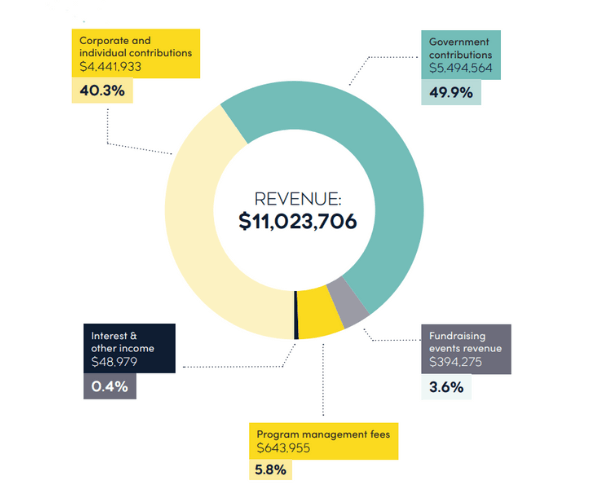
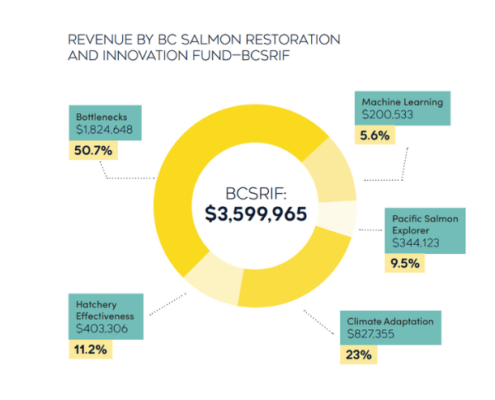
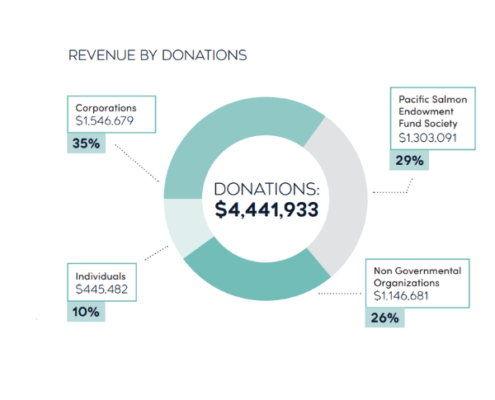

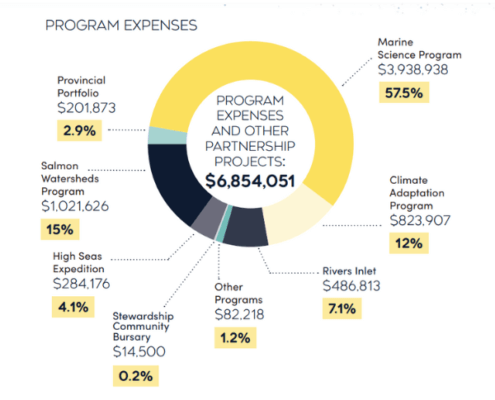
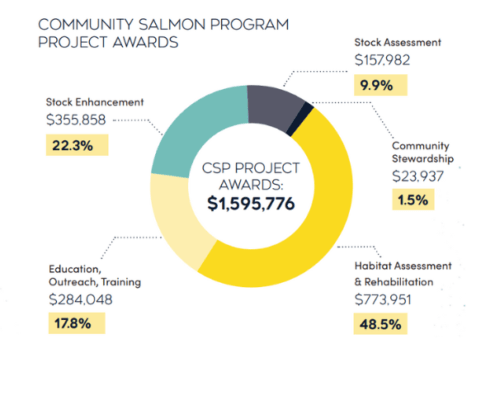
Special thanks to our generous supporters for advancing game-changing work to save and restore wild Pacific salmon.
The Salish Sea Marine Survival Project, a collaboration between Long Live the Kings and PSF, wrapped up in 2021; the present PSF Marine Science Program evolved from the project.
“Following the successes of the Salish Sea Marine Survival Project, we developed the Marine Science program, focussed on addressing key recommendations, applying actions to promote restoration and conservation of salmon, and continuing critical science. The program ranges from nearshore habitat restoration to salmon health, and is enhanced by the energy and passion of our many partners.” — Dr. Isobel Pearsall, Director, Marine Science Program
What affects the survival of young Chinook, Coho and Steelhead in the Salish Sea?
Twelve pathogens associated with poorer body condition and survival for Chinook, coho, and sockeye salmon in the southern Strait of Georgia were discovered.
The first study to find Piscine orthoreovirus and associated diseases in B.C.’s farmed salmon, the results prompted PSF to support a phase-out of open-net-pen salmon aquaculture in the province.
Fifteen previously undocumented viruses were discovered in Pacific salmon.
A study focused in the Cowichan River found that wild juvenile Chinook survived at twice the rate of their hatchery-produced counterparts. The big difference in survival rates between hatchery-produced and wild salmon has inspired a major spin-off study of hatchery effectiveness.
Critical bottlenecks to survival occur in the first few weeks at sea and during the initial winter in the salmon lifecycle.
Pacific herring are a key food source during this period and their availability likely helps determine salmon survival and growth.
The major impacts of predation were identified. Several recommendations emerged: removal of log booms in estuaries, water flow regulations, large-scale marine debris clean-up, and habitat restoration projects in Strait of Georgia communities.
Special thanks to RBC Foundation.
Coasts provide key habitat for spawning forage fish — crucial for Pacific salmon.
Climate change, sea-level rise and man-made structures contribute to habitat loss. Thanks to $1.9M from Environment and Climate Change Canada’s Climate Action and Awareness Fund, the Resilient Coasts for Salmon project launched to build public awareness and community capacity to adopt nature-based solutions. The team works with communities, stewardship groups, and coastal First Nations.
“We can take action in our coastal communities by using nature-based solutions to naturalize hardened shorelines, incorporating policies that help us plan for sea-level rise, and making changes in our daily lives to reduce our environmental impact on our shorelines.” – Kyla Sheehan, Manager and Biologist, PSF Resilient Coasts for Salmon project
Resilient Coats for Salmon Project Manager Kyla Sheehan working through a shoreline assessment exercise as part of a Green Shores® training session in Cadboro Bay, Victoria, B.C.
Photo by Maria Catanzaro, Resilient Coasts for Salmon project coordinator.
Competition, climate change, and predation adversely impact salmon. In partnership with the BC Conservation Foundation, DFO, BC Ministry of Food and Agriculture, and the University of Victoria, the Bottlenecks Program aims to pinpoint the events leading to declines in wild and hatchery Chinook, coho, and steelhead. More than 100,000 fish have been tagged with Passive Integrated Transponders (PIT), and tagging continues for freshwater and marine life phases to develop an understanding of where survival bottlenecks occur. PIT tag-detecting antenna arrays have been installed in several river systems on Vancouver Island.
“Our initial study in the Cowichan showed that through early life stages of Chinook, wild fish survived twice as well as their hatchery counterparts. Now, we’re applying what we learned from this study to other watersheds.” – Jamieson Atkinson, Project Co-manager and Biologist, British Columbia Conservation Foundation, a partner in the project.
This four-year project is funded through BCSRIF.
Staff from BCCF and FLNRORD add housing to protect important connection and communication cables on a panel that is part of a PIT antenna-array system in the Englishman River for the Bottlenecks project.
To better understand how infectious agents affect salmon, the program — a collaboration with DFO’s Dr. Kristi Miller and her laboratory — launched in 2021; the team applies cutting-edge genetic tools to monitor disease-related and environmental stresses in wild Pacific salmon, gauges impacts from open-net salmon farming, and identifies solutions to the problems uncovered.
The team published important findings indicating that Piscine orthoreovirus came to B.C. from Norway with the advent of salmon farming and now transfers regularly from farmed to wild salmon.
Working to support the Broughton Aquaculture Transition Initiative, run by the Mamalilikulla, ’Namgis, and Kwikwasut’inuxw Haxwa’mis First Nations, PSF helps monitor the health of salmon on farms and conducts eDNA water monitoring to support First-Nations-led observation and regulation.
PSF experts testified to Parliament’s Standing Committee on Fisheries and Oceans and participated in DFO consultations on its commitment to transition away from open-net salmon farming by 2025.
Field work at Quatsino Sound in 2019. Dr. Emiliano Di Cicco, PSF fish pathologist (left) and Dr. Andrew Bateman, manager of PSF’s Salmon Health Program (right).
PSF undertook a comprehensive review of hatchery release strategies in B.C. The report provides hatchery-specific information for managers to consider when planning releases and identifies locations with the greatest opportunities for improvement.
“The results explore the relationships between release strategies and salmon survival, and help us gain a better understanding of what works where. Both hatchery and wild salmon survival depend on the conditions they face as juveniles, so release strategies matter and there is no one-size-fits-all solution.” – Sam James, PSF Biologist
The Hatchery Effectiveness Review is supported through the BC Salmon Restoration and Innovation Fund (BCSRIF), a joint funding program by the Governments of Canada and British Columbia.
Chum eggs collected from spawning salmon at the Chehalis River Hatchery.
To better understand ocean conditions that drive food availability, volunteers provide a consistent stream of precise, almost real-time data on the Strait of Georgia.
Phytoplankton serve as the foundation of the entire marine ecosystem, and their dynamics in the Strait were unusual in 2021. Citizen Scientists observed and collected samples from thick and colourful blooms (i.e. Noctiluca, Heterocapsa). Although these species are not toxic, they cause cascading impacts to the ecosystem and food web. Algae responsible for shellfish harvest closures were among the highest observed on record. There were also temporal shifts in species dominance likely related to the unusually hot temperatures from the heat dome. Overall, surface waters were warmer and fresher than usual in the Strait in 2021.
“Our Citizen Science volunteers are amazing. I get to witness firsthand how passionate they are and how tirelessly they contribute their time and talent. Last year, they collected more than 5,000 samples that will help us understand conditions which are critical to salmon in the Strait.” –Svetlana Esenkulova, Biologist, PSF Citizen Science Oceanography Program.
Citizen scientists Gail and Ted Newell gather samples and collect measurements in the Strait of Georgia. Photo by Rob Newell.
With 54 educational maps and more than 12,000 documents, the Data Centre provides a one-stop shop for information on ecology, oceanography, and human use.
In 2021, the centre released:
1. The Strait of Georgia Marine Reference Guide, an interactive map that provides more than 400 spatial data layers on subjects from salmon stomach contents to hazardous debris in estuaries.
2. Story maps covering the following topics:
Juvenile Chinook salmon in a net pen at the Big Qualicum Hatchery.
Fish that grow faster, survive better, and the “readiness” of juvenile salmon to survive winters in the Gulf of Alaska may be determined during the first months at sea. The 2019 and 2020 voyages tested this hypothesis. 2021 saw the planning and coordination of the largest international effort for open ocean salmon research with scientists from Canada, Japan, the Republic of Korea, the Russian Federation, and the United States headed out to sea in the 2022 expedition organized through the North Pacific Anadromous Fish Commission (NPAFC).
These studies link the Bottlenecks to Survival project to the future ocean survival of juvenile salmon, providing a better picture of what impacts salmon survival.
The first two expeditions’ research results summarized by Dr. Brian Riddell in NPAFC’s Technical Report No. 18 included an extensive review of salmon production trends in the North Pacific region.
Special thanks to generous donors: Parkland and Canadian Fishing Company.
PSF biologist Svetlana Esenkulova conducting research on the 2020 High Seas Expedition.
The Salmon Watersheds Program works to inform key issues related to the conservation and management of Pacific salmon. Convening people across disciplines, organizations, and levels of government, the program works to establish a common understanding of the state of salmon and their habitats and supports partners in using this information to develop community-led monitoring and stewardship plans.
“With over 90% of all salmon Conservation Units now available in the Pacific Salmon Explorer, we have established a common foundation of information to understand the state of Pacific salmon and their habitats in B.C. This information is essential to inform salmon conservation and management decisions for long-term recovery.” — Dr. Katrina Connors, director, PSF Salmon Watersheds Program.
![]()
Making Pacific salmon data publicly accessible through interactive online tools.
![]()
Developing and applying new approaches for assessing conservation risks and evaluating management actions for salmon.
![]()
Completing data-driven assessments of wild Pacific salmonid populations and their habitats.
![]()
Supporting partners in developing strategic salmon conservation, restoration, and monitoring plans.
Haida Gwaii was added to the Pacific Salmon Explorer (PSE) as a collaborative effort with Haida Fisheries, DFO’s Salmon Enhancement Program, Parks Canada, the Gowgaia Institute, the Hecate Strait Streamkeepers, and independent salmon experts. Together they identified and helped document local salmon spawning areas and summarized the best data on the 765 salmon populations that spawn in Haida Gwaii. The tool now has information about more than 90 per cent of salmon across the province.
“With more than 90 per cent of all genetically distinct populations now available in the Pacific Salmon Explorer, we have established a common foundation of information for better understanding the state of Pacific salmon and their habitats in B.C. This is essential for informing conservation and management decisions that support salmon resilience.” — Dr. Katrina Connors, Director, PSF Salmon Watersheds Program
Salmon Watersheds Program team members Clare Atkinson and Kathleen Belton representing PSF at a research conference.
In collaboration with the Lower Fraser Fisheries Alliance (LFFA), the Salmon Watersheds Program developed a custom online planning tool to support the development of a habitat restoration plan for the Lower Fraser River. Working alongside LFFA member-Nations, the map-based tool visualizes local habitat pressures, historical restoration projects, and restoration priorities identified by the Lower Fraser Nations. An online story map outlines the state of salmon habitats and populations in the Lower Fraser River, and highlights the need for a coordinated, community-led approach to restoration.
“The Sto:lo have always had an inherent obligation to look after resources within our territories, Sohl Temexw. That obligation comes with looking after seven generations back to the time of our ancestors and seven generations forward. When governments were established 150 years ago, we were displaced and lost the ability to govern and manage resources within Sohl Temexw. In our Halqemeylem language Letsemot references the need to proceed with one heart, one mind, and recognize that all things are connected. Today we are all responsible to work collaboratively to figure out a way forward to make sure that the fish, the water, and resources are going to be here for future generations.” — Murray Ned, Executive Director, LFFA, PSF Board Member
Working in collaboration with the Central Coast Indigenous Resource Alliance (CCIRA), the Kitasoo/ Xai’xais, Nuxalk, Heiltsuk, and Wuikinuxv First Nations, DFO, and regional Charter Patrolmen, the team supported partners in developing a strategic vision for monitoring and stewarding Pacific salmon on the Central Coast of B.C. The report identifies strategies for establishing an Indigenous-led monitoring and stewarding framework — rooted in Indigenous values — for local salmon populations.
“Central Coast First Nations are working to develop capacity to manage their marine resources informed by work such as the Monitoring Framework. This framework will serve as a structured guide for strengthening the scientific foundations for fisheries governance approaches that support conservation and recovery efforts for wild Pacific salmon and the communities who depend upon them.” — Rich Chapple, President, CCIRA
Salmon Watersheds Program team members visit Bearskin Bay Salmon Hatchery in Haida Gwaii.
Since 2012, 100 per cent of proceeds generated through sales of the Salmon Conservation Stamp have been directed to PSF by the federal government to support the Community Salmon Program (CSP). CSP supports volunteers, community stewards, and First Nations — People for Salmon — who undertake salmon conservation projects.
“It is encouraging working with hundreds of passionate salmon advocates each year. The collective effort of this dedicated stewardship community results in remarkable outcomes for wild Pacific salmon.” — Jim Shinkewski, Director, PSF Community Salmon Program
Special thanks to generous donors: Encorp RETURN-IT, Methanex Corporation, Mosaic Forest Management, Neptune Terminals, Pembina Pipeline Corporation, Secure Energy Services, Teck Resources, and The Ultimate Port Alberni Fishing Derby.
Eco-Cultural Restoration in the K’omoks Estuary is a modification of Indigenous fish weir techniques to a more modern purpose of restoring critical estuary habitat for enhanced salmon survival. Overabundant Canada geese have grazed and denuded estuarine marshes on Vancouver Island for decades, leading to the loss of over 90 per cent of this important juvenile salmon habitat. The Guardians of Mid-Island Estuaries Society have pioneered unique and remarkably effective estuary restoration techniques at six estuaries since 2010.
“Due to intensive herbivory from introduced Canada geese, outside our exclosures can seem like an unvegetated, barren desert. As a wildlife biologist I get such a thrill to see salmonids utilizing the sedge habitat we’ve been able to save and create for them through our unique eco-cultural restoration techniques. Our greatest strength comes from our invaluable collaborations with our First Nations partners. The expertise and enthusiasm they bring to these restoration projects makes the job immensely productive and a lot of fun, too.” — Garreth Ashley, Field Biologist, Guardians of Mid-Island Estuaries Society
With the support of Cowichan Tribes biologists and volunteers from local stewardship groups, salmon stewards are undertaking a multi-year program to improve habitat conditions for coho, chum, and Chinook salmon throughout the Cowichan and Kokisilah watersheds.
“We’ve been working with the Pacific Salmon Foundation for over 10 years now. Our work with PSF is so important because the partnership enables us to work with young people to do important riparian restoration work.” – Jane Kilthei, President, Board of Directors, Cowichan Estuary Nature Centre
Quote source: The next generation of salmon stewardship – YouTube
European green crab are aggressive invasive predators found primarily in eelgrass and kelp — important nearshore juvenile salmon habitat. The crabs damage critical habitat, resulting in loss of prey and diminished survival for salmon. By increasing awareness of this prolific invasive species and developing capacity among the public to report and respond, the destructive impacts on coastal ecosystems and aquatic species can be mitigated.
“We are so excited to have the ‘Trapping and Licencing; European Green Crab’ eLearning course up and live on the Invasive Species Council of BC’s Learning Centre. It means we can empower people to take part in community science trapping initiatives to monitor for this very problematic crab. This has been a great opportunity to work alongside likeminded organizations like the PSF, to help protect B.C.’s biodiversity.” – Nadine McCosker, Learning Manager, ISCBC
Building the future of People for Salmon, the Bursary is awarded to students in B.C and the Yukon who are dedicated to the conservation and restoration of Pacific salmon and their habitat.
“I’ve always been fascinated by biological systems; I love studying life and all of the processes that facilitate it. My focus on physiology came down to me excelling in coursework as well as finding a phenomenal professor who became my mentor and sparked my passion and interest. This bursary has helped finance my education and research, and helped me achieve my degree.” — James Kennedy, Class of 2022, UBC Bachelor of Science, Biology.
James Kennedy, 2021 PSF Community Bursaries Program recipient.
At the Percy Walkus Hatchery, People for Salmon work to help Chinook rebound. This hatchery in Rivers Inlet run by the Wuikinuxv Nation and is supported by the Duncanby Lodge & Marina and Good Hope Cannery, DFO and PSF. It presents a model to conserve, restore, and enhance unique salmon stocks.
The hatchery employs advanced genetic tools and “parental-based tagging” — the gold standard in managing genetic diversity — making it possible to trace the parents of every hatchery fish that returns. Egg-to-fry survival is very high with coded-wire tag returns indicating that enhancement efforts are contributing to increased escapements over time.
“It was instilled in me that there should be enough salmon for today but also for those who aren’t here yet. Salmon affect all of us and it’s important that we have buy-in from sport and commercial fishing, First Nations, industry and government. If we don’t unify on salmon there will be none left.” – Ted Walkus, Hereditary Chief, Wuikinuxv First Nation
Special thanks to generous donors: Duncanby Lodge & Marina, Good Hope Cannery, and many individuals.
Climate change is the greatest threat facing Pacific salmon. In 2021, 150 People for Salmon convened for a workshop to discuss opportunities to moderate and mitigate climate-change effects on salmon.
For example, born from the workshop, the Thermal Refugia for Salmon project tests methods including the use of thermal sensing drones for identifying natural cool water areas for salmon during times of extreme temperatures. Locating areas of cool refuge is challenging as the work often relies on information provided by local swimmers, fisheries professionals, or people in streams. Knowing their locations can allow for better management and protection of habitats.
“There are numerous Chinook and sockeye salmon populations in the Upper Fraser that have been identified by COSEWIC [Committee on the Status of Endangered Wildlife in Canada] as endangered . . . With these declines come increased health issues and food security issues. Believe it or not, not everyone has the luxury of going to the local grocery store to meet their needs. Community leadership has been forced to impose restrictions, often founded by traditional laws and necessity, on their people, in order to preserve the biodiversity of salmon species and stocks that return to the respective territories for future generations.” — Gord Sterritt, PSF Board Member and Executive Director, Upper Fraser Fisheries Conservation Alliance, a collaborative stewardship body for First Nations.
With the support of BCSRIF, PSF launched the Climate Adaptation Program that prioritizes urgent action in three key areas:
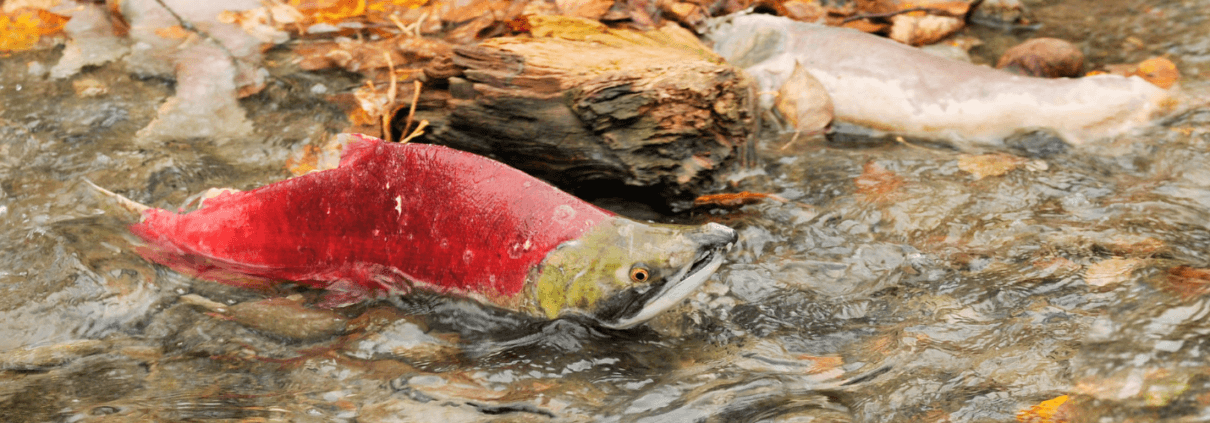
High flows in the Fraser pose migration difficulties for salmon. For example, in 2020, high flows led to salmon being held up for the first several weeks. With the goal of assessing potential impediments including existing fishways, PSF worked with the Matsqui and Yale First Nations to tag and track salmon migration patterns.

Wildfires lead to major changes in rivers and streams, destroying habitat, salmon, and their eggs. PSF’s fire recovery playbook focuses on the needs of salmon following wildfires and helps the forest industry, government agencies, First Nations, and conservation. Organizations identify impacts and risks. A comprehensive tool to inform priorities and actions, the playbook serves to identify and coordinate opportunities to manage post-fire impacts to salmon habitats, accelerate watershed recovery, and aid future responses.
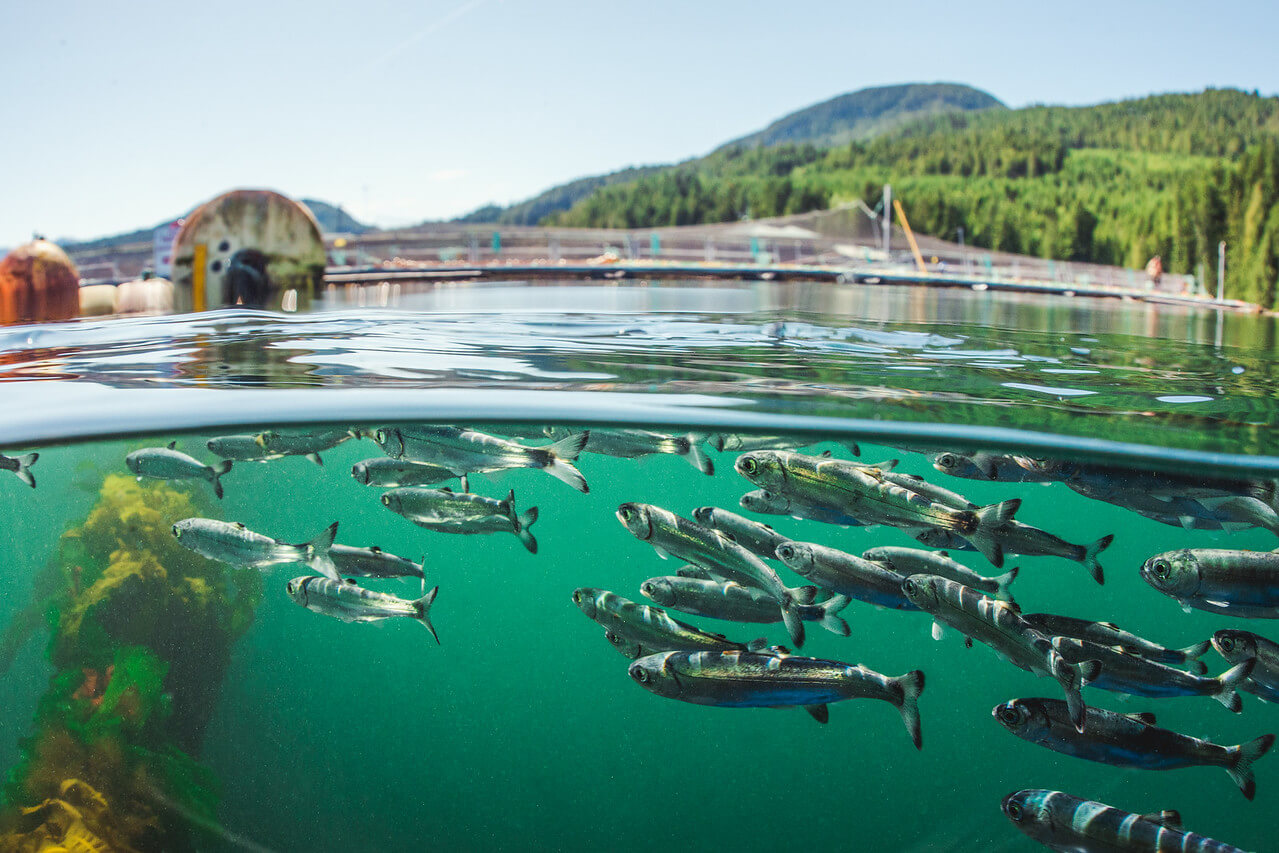
The program identifies key genetic adaptations that could be conserved through hatchery enhancement or habitat restoration to help salmon adjust better to climate change.
The unprecedented atmospheric river and flooding that occurred in late 2021 required an urgent and coordinated response to save salmon trapped in flooded fields and repair damaged spawning habitat.
PSF mobilized partnerships, secured funds, and supported response efforts, including:
supported the Sumas Nation and local experts with fish rescue efforts; 18 projects supporting at-risk habitat capable of producing several million juvenile salmon;
the Eaton Beaton side-channel, a tributary to the Nicola River, one of the most important rearing habitats for coho and early-run Chinook, and the most-important for steelhead;
supported the reconstruction of a channel in Chilliwack completely buried with sediment; the next day 40 adult coho showed up to spawn.
“These are our most endangered species of coho, so if we can save four females, then we save thousands of eggs.” — says Lester Ned, Semá:th First Nation, after rescuing salmon in Abbotsford B.C.
Special thanks to the PSEFS, Pacific Angler and Groupe Ocean for their generous support
Thank you to our generous supporters for advancing game-changing work to save and restore wild Pacific salmon.
“Many salmon populations have experienced major declines, and 2021 showed us how climate change is bringing additional challenges.
However, with our help, these resilient fish can recover. We have a responsibility to help turn things around. The PSF team, along with the work of our partners and supporters, is helping to make things better, contributing towards healthy and sustainable salmon populations for future generations.”
—Jason Hwang, VP Salmon, PSF
Special thank you to the following donors for generously contributing to PSF in 2021 with cumulative contributions of over $100,000.